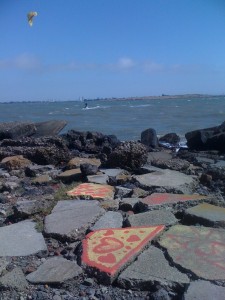Landfill isn’t a very pretty word. It is a slightly nicer term for trash. Landfills are often equated with the dump – places you banish ugly, unwanted things to. And many times that is what they are: Sites only good enough to hold someone else’s waste. Graves for things people got over.
But landfills are also a place of second chances. Where items are plucked from the heap by someone with a different vision. Salvaged for a different purpose entirely. This transformation process can occur by using materials no longer needed on one site and transporting it to another where it is. The material, often excess soil and sand from construction zones, is recycled to give new life. We call it landfill. It still sounds like refuse.
D and I recently visited the Albany Bulb in East Bay. It is the site of the former City of Albany’s dump, constructed from rebar and rock and concrete. It has lay fallow since the 1980s when filling efforts ceased due to litigation.
The Albany Bulb lacks ongoing police patrol. The area is largely unregulated and has become a space owned by no one. And everyone. While the city aims to transfer responsibility and upkeep of the land to the auspices of the state parks department, sea birds, local homeless populations, artists and environmentalists have taken stake in its development. For now, it is a beautiful anarchy.
Over the past decade urban artists have erected sculptures using found materials and painted colorful murals on reclaimed wood. A small castle of plaster and spray paint sits back from the water. Broken glass carpets the floor. You wonder why people always need to leave pieces of themselves behind. Slabs of concrete covered in graffiti jut from the waves. You aren’t really sure if it ever belonged there, if it ever made sense of itself along the water’s edge.
There is a small network of trails cutting paths through overgrown dry grass. Homeless encampments decorate the hillside. A community library – a one-room shack – houses a collection without requirements. You do not need a card to partake. Just come and abide by one rule: Enjoy and contribute. Or leave. A sign inside reads: “Do not shipwreck this space.” A dustpan and brush hang along the wall. A broken American flag windowpane keeps out the wild blackberry bushes in the back. The air is tinged with urine.
The shack is punctuated by a makeshift flagpole flying an American flag. A hammock is caught between two trees out front with beer bottles dangling from their branches. The front yard harbors renderings of presidents and Jesus, an organ that has seen better days, and ropes tied to nothing. Unknown builders have tacked several flags around the front window highlighting their allegiance to no one in particular.
And they will eventually be dismantled.
Throughout the hike I snapped photos of the art and graffiti. I noticed one word kept reappearing on the rocks, painted on shards of concrete, spray painted along the walls of the castle, etched in the wood, and stamped on the walkways: love.
Love was everywhere in this abandoned space.
And after looking beyond the broken glass, the beer cans resting in fire pits, shopping carts parked in the shadows, rusted rebar poking through the weeds – you start to see the beauty in this place. Flowers push through cracks of concrete. Birds fly over untouched golden fields. There is life here. And it is thriving. The messages seemed fitting and clear of the site. As if saying to those who question its existence: I have many flaws. I cannot offer you much. But I am many things. And I still deserve a chance.
Below are some photos of what remains at the Albany Bulb.
 One of the many hearts left behind.
One of the many hearts left behind.
 A heart shaped house. With a message.
A heart shaped house. With a message.
 Looking across the Bay is San Francisco. Someone cares for that place too.
Looking across the Bay is San Francisco. Someone cares for that place too.